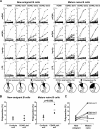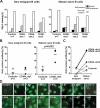CD40 ligand and MHC class II expression are essential for human peripheral B cell tolerance
- PMID: 17562816
- PMCID: PMC2118633
- DOI: 10.1084/jem.20062287
CD40 ligand and MHC class II expression are essential for human peripheral B cell tolerance
Abstract
Hyper-IgM (HIGM) syndromes are primary immunodeficiencies characterized by defects of class switch recombination and somatic hypermutation. HIGM patients who carry mutations in the CD40-ligand (CD40L) gene expressed by CD4(+) T cells suffer from recurrent infections and often develop autoimmune disorders. To investigate the impact of CD40L-CD40 interactions on human B cell tolerance, we tested by ELISA the reactivity of recombinant antibodies isolated from single B cells from three CD40L-deficient patients. Antibody characteristics and reactivity from CD40L-deficient new emigrant B cells were similar to those from healthy donors, suggesting that CD40L-CD40 interactions do not regulate central B cell tolerance. In contrast, mature naive B cells from CD40L-deficient patients expressed a high proportion of autoreactive antibodies, including antinuclear antibodies. Thus, CD40L-CD40 interactions are essential for peripheral B cell tolerance. In addition, a patient with the bare lymphocyte syndrome who could not express MHC class II molecules failed to counterselect autoreactive mature naive B cells, suggesting that peripheral B cell tolerance also depends on major histocompatibility complex (MHC) class II-T cell receptor (TCR) interactions. The decreased frequency of MHC class II-restricted CD4(+) regulatory T cells in CD40L-deficient patients suggests that these T cells may mediate peripheral B cell tolerance through CD40L-CD40 and MHC class II-TCR interactions.
Figures






References
-
- Winkelstein, J.A., M.C. Marino, H. Ochs, R. Fuleihan, P.R. Scholl, R. Geha, E.R. Stiehm, and M.E. Conley. 2003. The X-linked hyper-IgM syndrome: clinical and immunologic features of 79 patients. Medicine (Baltimore). 82:373–384. - PubMed
-
- Gulino, A.V., and L.D. Notarangelo. 2003. Hyper IgM syndromes. Curr. Opin. Rheumatol. 15:422–429. - PubMed
-
- Durandy, A., S. Peron, and A. Fischer. 2006. Hyper-IgM syndromes. Curr. Opin. Rheumatol. 18:369–376. - PubMed
-
- Korthauer, U., D. Graf, H.W. Mages, F. Briere, M. Padayachee, S. Malcolm, A.G. Ugazio, L.D. Notarangelo, R.J. Levinsky, and R.A. Kroczek. 1993. Defective expression of T-cell CD40 ligand causes X-linked immunodeficiency with hyper-IgM. Nature. 361:539–541. - PubMed
-
- Lee, W.I., T.R. Torgerson, M.J. Schumacher, L. Yel, Q. Zhu, and H.D. Ochs. 2005. Molecular analysis of a large cohort of patients with the hyper immunoglobulin M (IgM) syndrome. Blood. 105:1881–1890. - PubMed
Publication types
MeSH terms
Substances
Grants and funding
LinkOut - more resources
Full Text Sources
Research Materials

